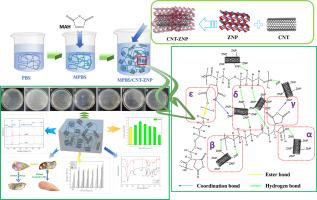Enhanced performance of nanoplate-carbon nanotube reinforced poly(butylene succinate) nanocomposites for sustainable packaging and multifunctional applications
IF 8.2
1区 农林科学
Q1 CHEMISTRY, APPLIED
引用次数: 0
Abstract
This study developed modified poly (butylene succinate) (MPBS) nanocomposites reinforced with ZnO nanoplate-decorated carbon nanotubes (CNT-ZNP) to improve mechanical, thermal, and functional properties for food packaging applications. MPBS was synthesized via grafting of maleic anhydride to enhance compatibility with nanofillers. Incorporation of only 0.1 g/hg CNT-ZNP led to substantial improvements in tensile strength (36.5 %), elongation at break (108.6 %), and yield strength (41.6 %), demonstrating that enhanced performance can be achieved with minimal nanofiller content. The nanocomposite also exhibited enhanced crystallinity, thermal stability, and water vapor barrier performance. Food preservation tests demonstrated that MPBS/CNT-ZNP films effectively maintained banana freshness over 14 days and inhibited microbial growth in raw chicken for up to 108 h. These outcomes highlight the material's potential to extend shelf life and reduce spoilage in perishable products. Overall, the MPBS/CNT-ZNP nanocomposites combine mechanical robustness with antimicrobial and preservation functionality, supporting their application as sustainable and multifunctional food packaging films.

纳米板-碳纳米管增强聚丁二酸丁二烯纳米复合材料的可持续包装和多功能应用
本研究开发了以ZnO纳米板修饰碳纳米管(CNT-ZNP)增强改性聚丁二酸丁二烯(MPBS)纳米复合材料,以改善食品包装的机械、热学和功能性能。通过接枝马来酸酐合成了MPBS,提高了与纳米填料的相容性。仅加入0.1 g/hg的CNT-ZNP就能显著提高抗拉强度(36.5%)、断裂伸长率(108.6%)和屈服强度(41.6%),这表明纳米填充剂含量最少就能提高性能。纳米复合材料还表现出增强的结晶度、热稳定性和水蒸气阻隔性能。食品保鲜试验表明,MPBS/CNT-ZNP薄膜能有效地保持香蕉14天以上的新鲜度,并能抑制生鸡肉中的微生物生长长达108小时。这些结果突出了该材料在延长保质期和减少易腐产品腐败方面的潜力。总体而言,MPBS/CNT-ZNP纳米复合材料将机械坚固性与抗菌和保存功能相结合,支持其作为可持续和多功能食品包装薄膜的应用。
本文章由计算机程序翻译,如有差异,请以英文原文为准。
求助全文
约1分钟内获得全文
求助全文
来源期刊

Food Chemistry: X
CHEMISTRY, APPLIED-
CiteScore
4.90
自引率
6.60%
发文量
315
审稿时长
55 days
期刊介绍:
Food Chemistry: X, one of three Open Access companion journals to Food Chemistry, follows the same aims, scope, and peer-review process. It focuses on papers advancing food and biochemistry or analytical methods, prioritizing research novelty. Manuscript evaluation considers novelty, scientific rigor, field advancement, and reader interest. Excluded are studies on food molecular sciences or disease cure/prevention. Topics include food component chemistry, bioactives, processing effects, additives, contaminants, and analytical methods. The journal welcome Analytical Papers addressing food microbiology, sensory aspects, and more, emphasizing new methods with robust validation and applicability to diverse foods or regions.
 求助内容:
求助内容: 应助结果提醒方式:
应助结果提醒方式:


